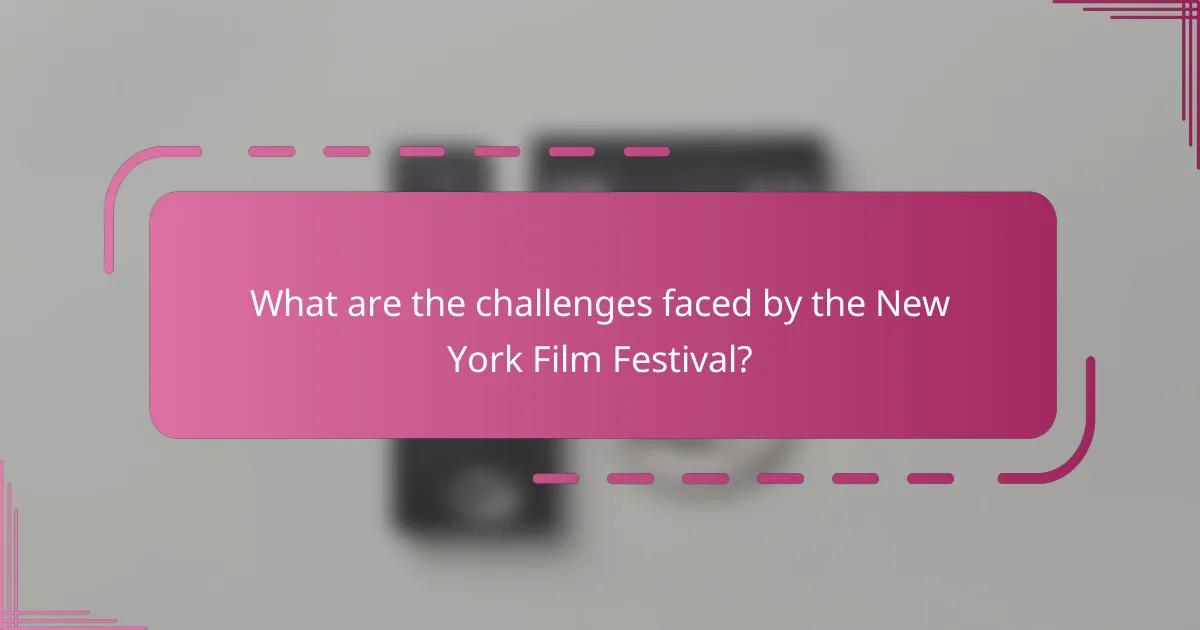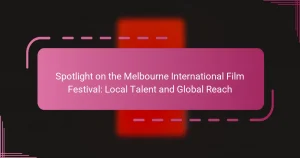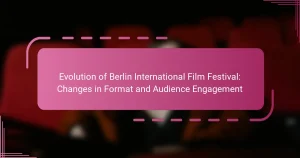The New York Film Festival (NYFF) is an established annual film festival in New York City, showcasing a curated selection of international and American films since its inception in 1963. Organized by the Film Society of Lincoln Center, the festival emphasizes artistic innovation and features premieres of both narrative and documentary films, alongside special events and discussions with filmmakers. The audience’s experience significantly influences the festival’s programming, as curators prioritize films that resonate with current interests and trends, fostering community engagement. However, the NYFF faces challenges such as competition from other festivals, funding issues, and the need to adapt to changing audience preferences in the evolving landscape of film consumption.

What is the New York Film Festival?
The New York Film Festival (NYFF) is an annual film festival held in New York City. It showcases a selection of international and American films. Founded in 1963, it is one of the oldest film festivals in the United States. The festival typically features premieres of notable films, including both narrative and documentary works. It is organized by the Film Society of Lincoln Center. The NYFF aims to present a diverse range of cinematic voices. Each edition includes special events, discussions, and Q&A sessions with filmmakers. The festival is known for its curatorial vision that emphasizes artistic innovation.
How has the New York Film Festival evolved over the years?
The New York Film Festival has evolved significantly since its inception in 1963. Initially, it focused primarily on showcasing international films. Over the years, it expanded to include a wider range of genres and styles. The festival began to feature more American films, highlighting new voices in cinema. In the 1970s, it introduced a more curated selection, emphasizing artistic merit. The festival also began to host discussions and panels with filmmakers. By the 1990s, it became a platform for premieres of major films. In recent years, it has embraced digital and virtual formats, adapting to changing audience preferences. The festival continues to reflect current trends in filmmaking and cultural discourse.
What were the key milestones in the festival’s history?
The New York Film Festival (NYFF) has several key milestones in its history. It was first held in 1963, establishing itself as a prominent cultural event. The festival introduced the “World Premiere” concept, showcasing new films before their general release. In 1970, it became a member of the International Federation of Film Producers Associations. The festival expanded its audience reach in 1995 by incorporating digital screenings. In 2001, NYFF launched the “Spotlight on Documentary” section, emphasizing the importance of documentary films. The 2010 festival featured a significant retrospective of director Martin Scorsese. In 2020, the festival adapted to the pandemic by offering a virtual format, ensuring continued accessibility. These milestones reflect the festival’s evolution and its impact on the film industry.
How has the festival’s programming changed over time?
The festival’s programming has evolved significantly since its inception in 1963. Initially, it focused primarily on American films and a limited selection of international works. Over the years, the festival expanded to include a more diverse range of global cinema. This shift reflects changes in audience interests and the film industry. In the 1980s, programming began to emphasize independent filmmakers and innovative storytelling. More recently, the festival has incorporated immersive experiences and digital formats. The inclusion of virtual screenings during the COVID-19 pandemic marked a pivotal change in accessibility. These adaptations illustrate the festival’s responsiveness to cultural trends and technological advancements.
What is the significance of the New York Film Festival in the film industry?
The New York Film Festival (NYFF) is significant in the film industry as it serves as a premier platform for showcasing innovative and diverse cinematic works. Established in 1963, it highlights both established and emerging filmmakers. NYFF features a curated selection of films that often include world premieres and critical favorites. This festival attracts industry professionals, critics, and audiences, fostering important discussions about film. It also influences award season dynamics, as many films gain traction through their NYFF screenings. The festival’s reputation for quality helps elevate the profiles of participating films and filmmakers. Overall, NYFF plays a crucial role in shaping cinematic trends and promoting artistic expression within the industry.
How does the festival influence filmmakers and audiences?
The festival influences filmmakers by providing a platform for exposure and networking. Filmmakers showcase their work to industry professionals and potential investors. This exposure can lead to distribution deals and collaborations. For audiences, the festival offers access to diverse films that may not be available in mainstream theaters. It fosters a community experience through screenings and discussions. Audiences engage with filmmakers during Q&A sessions, enhancing their understanding of the films. The festival also shapes audience preferences by introducing innovative storytelling techniques. Overall, it creates a symbiotic relationship between filmmakers and audiences, enriching the cinematic landscape.
What role does the festival play in film distribution and promotion?
Film festivals play a crucial role in film distribution and promotion. They serve as platforms for filmmakers to showcase their work to industry professionals and audiences. Festivals often attract distributors looking for new content. Successful screenings can lead to distribution deals for films. They provide visibility and media coverage, enhancing a film’s marketability. Festivals also facilitate networking opportunities among filmmakers, distributors, and critics. Additionally, awards won at festivals can boost a film’s reputation and audience interest. The New York Film Festival, for example, highlights innovative cinema and connects creators with potential distributors.
What are the core curatorial visions behind the New York Film Festival?
The core curatorial visions behind the New York Film Festival focus on showcasing innovative and diverse storytelling. The festival aims to present a mix of established and emerging filmmakers. It emphasizes artistic expression and cultural significance in film. The selection process prioritizes films that challenge conventions and provoke thought. Additionally, the festival seeks to create a dialogue between filmmakers and audiences. This vision is reflected in its diverse programming that spans genres and styles. The festival also highlights international cinema, promoting global perspectives. Overall, the curatorial approach fosters an inclusive environment for cinematic exploration.
How do curators select films for the festival?
Curators select films for the festival based on artistic merit and thematic relevance. They review numerous submissions and consider factors such as originality, storytelling, and technical execution. Curators also prioritize films that resonate with current cultural conversations. Additionally, they aim to showcase diverse voices and perspectives. The selection process often involves screenings and discussions among curatorial teams. Feedback from previous festivals can influence future selections. Ultimately, the goal is to create a cohesive program that engages audiences and sparks dialogue.
What themes and narratives are emphasized in the curatorial vision?
The curatorial vision emphasizes themes of diversity, innovation, and cultural reflection. These themes highlight the importance of representing varied perspectives in film. The narrative often focuses on underrepresented voices and stories. Innovation is celebrated through new storytelling techniques and formats. Cultural reflection encourages audiences to engage with contemporary societal issues. This approach fosters a deeper understanding of global narratives. The festival showcases films that challenge traditional norms and provoke thought. Overall, the curatorial vision aims to create an inclusive and thought-provoking cinematic experience.

How does audience experience shape the New York Film Festival?
Audience experience shapes the New York Film Festival by influencing programming and event design. The festival curators prioritize films that resonate with audience interests and trends. Feedback from previous attendees informs future selections. Audience demographics impact the types of films showcased. Engaging discussions and Q&A sessions enhance the overall experience. The festival also adapts to audience preferences for formats and genres. This responsiveness fosters a sense of community among film lovers. Ultimately, the audience’s reactions and engagement guide the festival’s evolution each year.
What are the primary elements of audience experience at the festival?
The primary elements of audience experience at the festival include film selection, venue atmosphere, and audience engagement. Film selection involves curating a diverse range of films that cater to various tastes. This diversity enhances the overall enjoyment and satisfaction of attendees. Venue atmosphere contributes significantly to audience experience. Comfortable seating, sound quality, and visual presentation are crucial factors. Audience engagement encompasses interactive discussions, Q&A sessions, and networking opportunities. These elements foster a sense of community among attendees. Together, they create a memorable and immersive experience at the festival.
How does the festival enhance viewer engagement?
The festival enhances viewer engagement through interactive programming and curated experiences. It offers Q&A sessions with filmmakers after screenings. This allows audiences to connect directly with creators. The festival also hosts panel discussions that explore thematic elements of the films. These discussions encourage audience participation and deeper understanding. Furthermore, the festival includes networking events for attendees to share insights. Such opportunities foster a sense of community among film enthusiasts. Overall, these elements create a more immersive viewing experience.
What amenities and services are offered to festival attendees?
The New York Film Festival offers various amenities and services to enhance the experience of attendees. These include access to screenings of a diverse range of films. Attendees can also participate in panel discussions and Q&A sessions with filmmakers. The festival provides food and beverage options at various venues. Additionally, there are merchandise stalls featuring festival-related items. Accessibility services are available for individuals with disabilities. Networking opportunities are facilitated through special events and receptions. Information desks are set up to assist attendees with inquiries. These offerings contribute to a comprehensive festival experience.
How does audience feedback influence future festivals?
Audience feedback significantly influences future festivals by shaping programming decisions and enhancing attendee experiences. Organizers analyze feedback to identify popular films and themes. This data helps in curating future lineups that align with audience preferences. Additionally, feedback on logistics, such as venue choice and scheduling, informs operational improvements. For instance, the New York Film Festival often adjusts its offerings based on audience surveys. This approach fosters a more engaging environment. Ultimately, incorporating audience insights leads to increased satisfaction and attendance in subsequent festivals.
What methods are used to gather audience feedback?
Surveys and questionnaires are commonly used methods to gather audience feedback. These tools can be distributed online or in-person during events. They allow organizers to collect quantitative and qualitative data. Interviews provide another method for in-depth audience insights. Focus groups can also be utilized to facilitate discussions among attendees. Social media platforms serve as informal channels for real-time feedback. Observational studies help in understanding audience reactions during screenings. Each method contributes valuable information to enhance future events.
How is feedback incorporated into programming decisions?
Feedback is incorporated into programming decisions through audience surveys and critiques. These tools gather insights on viewer preferences and experiences. Programming teams analyze this feedback to refine film selections. They aim to enhance audience engagement and satisfaction. Historical data shows that festivals using feedback see increased attendance. For instance, the Toronto International Film Festival utilizes audience ratings to shape future programming. This evidence supports the effectiveness of feedback in decision-making processes.

What are the challenges faced by the New York Film Festival?
The New York Film Festival faces several challenges. One significant challenge is competition from other film festivals. Many festivals attract similar audiences and filmmakers. This can dilute attendance and submissions. Another challenge is funding and sponsorship. Economic fluctuations can impact financial support. Additionally, the festival must adapt to changing audience preferences. The rise of streaming services influences how films are consumed. Lastly, the festival faces logistical challenges, such as venue availability and scheduling conflicts. These factors can complicate planning and execution.
What logistical challenges impact the festival’s execution?
Logistical challenges impacting the festival’s execution include venue availability, scheduling conflicts, and resource allocation. Venue availability can limit the number of screenings and events held. Scheduling conflicts may arise with filmmakers and talent, affecting attendance. Resource allocation involves managing budgets, staff, and equipment effectively. Additionally, transportation logistics for films and guests can complicate planning. Weather conditions may also disrupt outdoor events. These factors collectively influence the overall success of the festival.
How do funding and sponsorship affect the festival?
Funding and sponsorship significantly influence the festival’s operations and programming. They provide essential financial resources that enable the festival to secure venues, hire staff, and promote events. Increased funding allows for a broader selection of films and higher-profile guests, enhancing the festival’s prestige. Sponsorship can also lead to marketing opportunities that attract larger audiences. For example, major sponsors often facilitate partnerships that expand outreach efforts. Moreover, funding impacts the festival’s ability to offer workshops and panels, enriching the overall experience for attendees. Ultimately, the level of financial support directly correlates with the festival’s scale and quality.
What measures are taken to ensure accessibility for all audiences?
The New York Film Festival implements various measures to ensure accessibility for all audiences. These include providing closed captioning and audio descriptions for films. Additionally, the festival offers wheelchair access at venues. Accessible seating is designated for individuals with mobility impairments. Sign language interpreters are available for select events. The festival also provides materials in multiple formats to accommodate diverse needs. These measures comply with the Americans with Disabilities Act (ADA) standards. Overall, the festival prioritizes inclusivity in its programming and facilities.
How does the festival adapt to changes in the film landscape?
The festival adapts to changes in the film landscape by embracing new technologies and trends. It incorporates digital platforms for screenings and discussions. This allows for broader accessibility to diverse audiences. The festival also highlights emerging filmmakers and innovative storytelling techniques. It regularly updates its programming to reflect current cinematic trends. For instance, recent years have seen an increase in virtual reality and interactive experiences. Additionally, the festival engages in collaborations with industry leaders. These collaborations help to stay relevant in a rapidly evolving film industry.
What trends in film and technology are influencing the festival?
Current trends in film and technology significantly influence the festival landscape. Streaming platforms have reshaped distribution models, allowing wider access to films. This shift encourages filmmakers to explore diverse narratives. Virtual reality and augmented reality technologies are gaining traction, enhancing viewer engagement. Moreover, advancements in cinematography, such as 4K and 8K resolution, elevate visual storytelling. Data analytics are increasingly used to understand audience preferences, guiding programming decisions. Additionally, sustainability practices are becoming essential in festival planning. These trends collectively shape the future of film festivals, including the New York Film Festival.
How does the festival respond to shifts in audience preferences?
The festival adapts its programming to align with audience preferences. It conducts surveys and analyzes attendance data to understand viewer interests. This feedback informs the selection of films and events. The festival also incorporates diverse genres and themes to attract a wider audience. For example, recent festivals featured more international films and documentaries. The inclusion of panels and discussions reflects audience demand for engagement. Additionally, the festival utilizes social media to gauge real-time reactions and preferences. This responsive approach ensures the festival remains relevant and appealing to its audience.
What tips can enhance the audience experience at the New York Film Festival?
To enhance the audience experience at the New York Film Festival, attendees should plan their schedule in advance. This allows for optimal viewing of featured films and events. Engaging with festival programs can provide insights into film selections and panel discussions. Arriving early to screenings ensures better seating and a relaxed atmosphere. Participating in Q&A sessions with filmmakers can deepen understanding and appreciation of the films. Networking with fellow attendees can foster connections and discussions about the films. Utilizing festival apps or websites for real-time updates can improve navigation and scheduling. Lastly, exploring festival-related events and activities can enrich the overall experience.
How can attendees best navigate the festival schedule?
Attendees can best navigate the festival schedule by utilizing the official festival app. This app provides real-time updates on screenings, locations, and changes. Attendees should also review the printed schedule distributed at the festival. This schedule includes vital information such as film titles, times, and venues. Additionally, planning ahead is crucial. Attendees should prioritize films they want to see and create a personalized itinerary. Engaging with festival staff for assistance can also enhance navigation. They are knowledgeable about the schedule and can offer recommendations. Lastly, attendees should allow extra time between screenings to accommodate any delays. This approach ensures a smoother festival experience.
What strategies can enhance film selection for festival-goers?
Curated film selection enhances festival-goers’ experience through targeted programming. This involves identifying audience preferences and trends. Data analysis of previous festivals can reveal popular genres and themes. Incorporating diverse voices in film selection broadens appeal. Engaging with local filmmakers fosters community connection. Offering curated recommendations simplifies decision-making for attendees. Interactive platforms can provide personalized film suggestions. Collaborating with influencers can increase awareness and interest in selected films.
The New York Film Festival (NYFF) is an annual event held in New York City, showcasing a diverse selection of international and American films since its founding in 1963. The festival highlights premieres, engages audiences through discussions, and emphasizes artistic innovation in its curatorial vision. Key topics include the evolution of the festival over time, its significance in the film industry, audience experience, and the challenges it faces, all while adapting to changing trends in filmmaking and technology. The article also explores how audience feedback shapes programming decisions and enhances overall engagement at the festival.


